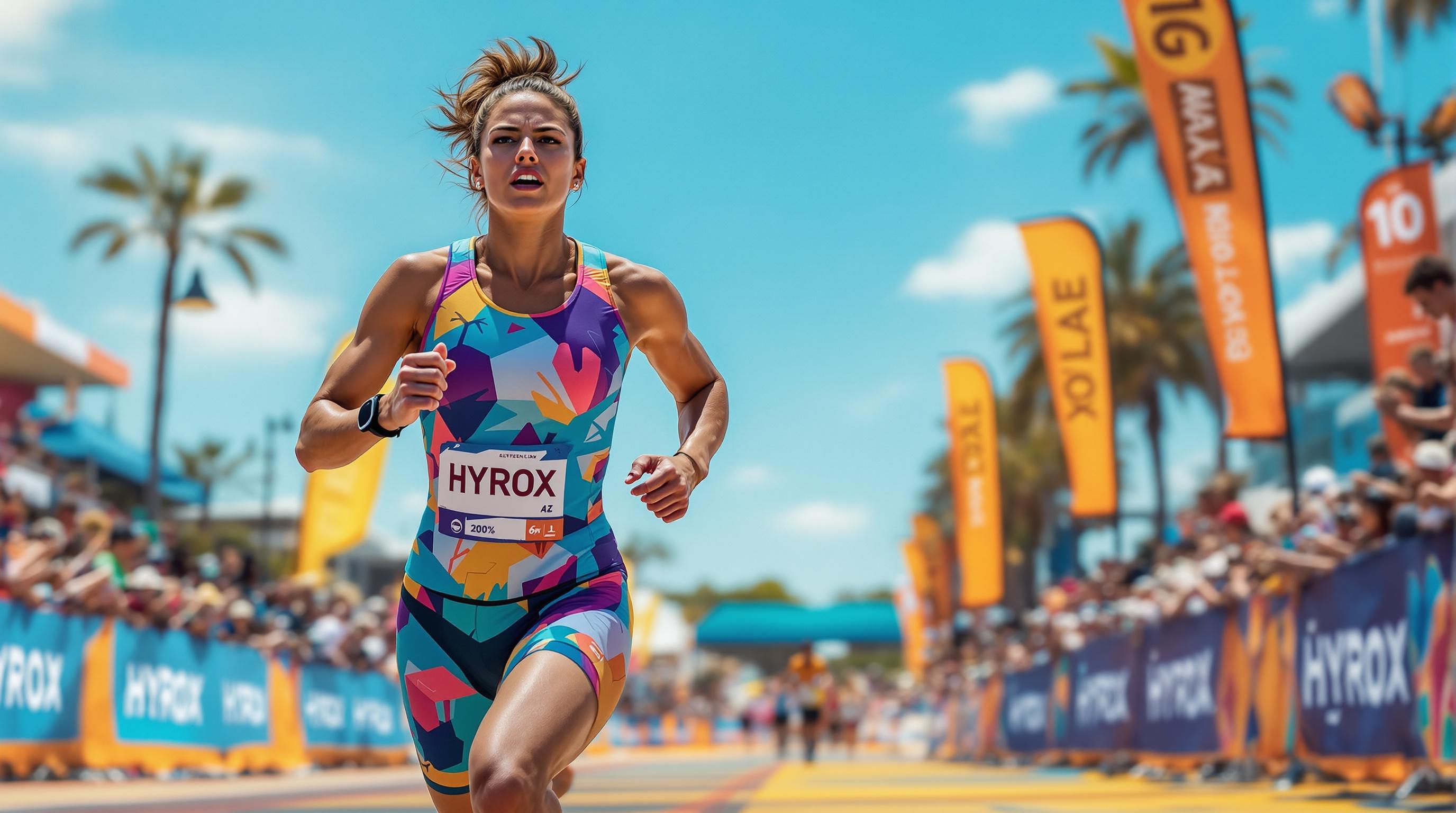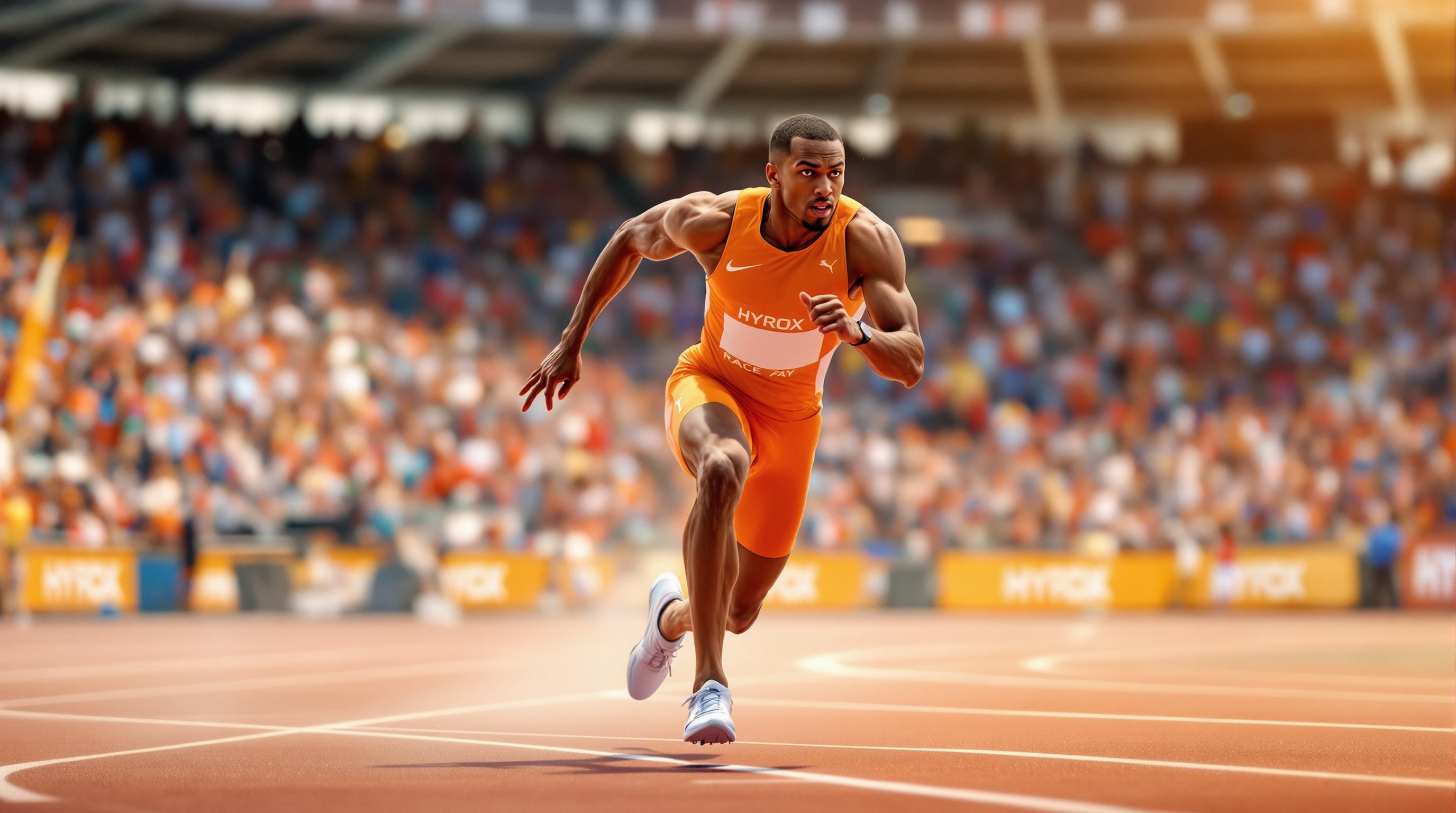Want to crush your next Hyrox race? Here's what you need to know about running and rowing:
- Running is crucial: 8km of running makes up half your race time
- Rowing builds full-body strength: Works 86% of your muscles
- Combine both for best results: Mix running and rowing in your training
Quick comparison:
| Aspect | Running | Rowing |
|---|---|---|
| Impact | High | Low |
| Muscles used | Mainly legs | Full body |
| Calories burned (20 min) | 255 | 178 |
| Recovery time | Longer | Shorter |
Bottom line: Run to build race endurance, row for strength and active recovery. Pick the one you enjoy most for consistent training.
Related video from YouTube
Cardio Needs in Hyrox
Hyrox isn't your average cardio workout. It's a beast that demands a special kind of fitness. Picture this: you're running 1km, then BAM! You're doing a functional workout. Then it's back to running. And you do this EIGHT times.
How Your Body Uses Energy in Hyrox
Your body's energy systems? They're on a wild ride during Hyrox. The key player here is your lactate threshold - that's when your body can't clear lactate as fast as it's making it. This becomes a big deal during those runs after you've just crushed a tough workout.
"To succeed in HYROX, athletes need to master not just running but also the ability to perform these exercises efficiently, whilst under fatigue." - Greg Williams, HYROX competitor, coach, and commentator.
Want to crush Hyrox? You've got to train that lactate threshold. Mix high-intensity intervals with steady cardio. This combo helps you keep pushing when others are fading.
8km Running in Hyrox
Don't be fooled by the 8km total distance. This isn't your Sunday jog in the park. You're running each kilometer after a workout that's just pushed you to the limit. Elite women? They're knocking this out in about 23 minutes 49 seconds. Elite men? Around 30 minutes 24 seconds.
What makes Hyrox running so tough is the constant switch-up. One minute you're sprinting through a workout, the next you're settling into a run. Your heart and lungs need to be ready for anything. Your training should mimic this back-and-forth.
Rowing Station Rules
The rowing station is its own beast. Here's the lowdown:
| Category | Damper Setting | Distance |
|---|---|---|
| Women's Open | Level 5 | 1000m |
| Women's Pro & Men's Open | Level 6 | 1000m |
| Men's Pro | Level 7 | 1000m |
Get this: you MUST strap your feet in before touching the handle. And don't even think about leaving until the judge gives you the nod. With half a million athletes expected to compete worldwide in the 2024-25 season, knowing these rules cold can save you from costly time penalties.
Running vs Rowing: How They Work
Running and rowing hit your body in very different ways during Hyrox. Let's break it down:
Muscles Used
Running? It's all about your legs. Your quads, hamstrings, calves, and hip flexors do the heavy lifting. Your core helps keep you steady, but your upper body's mostly along for the ride.
Rowing? That's a whole-body party. The English Institute of Sport says a single rowing stroke uses 86% of your muscles. Here's how it breaks down:
- Legs push off hard at the start
- Core controls the movement
- Upper body (back, shoulders, arms) finishes the job
Hollis Tuttle, a CityRow instructor, puts it this way:
"Rowing is primarily leg driven... you also have to push away with your legs, which is the major part of the stroke."
Calories and Energy Use
Let's talk numbers. For a 169-pound athlete:
- 20 minutes of moderate rowing = 178 calories burned
- 20 minutes of running (10-minute mile pace) = 255 calories burned
Running wins the calorie-burning contest. But here's the kicker for Hyrox: rowing builds strength while you do cardio. That's huge when you're facing those tough functional fitness stations between runs.
| Activity | Calories/20 min (169 lb person) | Primary Energy System |
|---|---|---|
| Running (10-min mile) | 255 | Aerobic |
| Rowing (moderate) | 178 | Aerobic + Muscular |
Impact on Body and Rest Time
Your joints will definitely feel the difference:
- Running: High-impact. Each step sends force through your feet, ankles, knees, and hips. This makes recovery between training sessions tougher.
- Rowing: Smooth and low-impact. You can train more often with less risk of overuse injuries.
Josh Honore, a NASM certified trainer at Row House, explains:
"The top benefit of rowing is the ability to train your cardiovascular system without putting loads of stress on our joints."
For Hyrox athletes, this matters big time. You need consistent training without breaking down. Rowing can be great for active recovery days or when you want to build strength without trashing your legs before a big running session.
Understanding these differences helps you plan smarter. Mix and match running and rowing to keep your body strong and ready for Hyrox's challenges.
Why Running Helps in Hyrox
Running isn't just a part of Hyrox - it's the core of the race. With 8x1km runs making up about half your race time, improving your running directly impacts your performance. Let's break down why running is so crucial:
Building Race Endurance
A typical Hyrox race lasts over 90 minutes, and you need to keep your running strong throughout. Top athletes spend more than 30 minutes in the "run plus rox zone" - that's some serious stamina.
To build this endurance, you need volume. Rich Ryan, RMR Coach and Hyrox Elite 15, puts it bluntly:
"To complete your absolute best Hyrox, you need to be a better runner."
Aim for 30-40 miles per week across five days. Increase your weekly distance by 10% for safe progression. Mix these three key run types:
- Easy runs (zone 2/3) to build base fitness
- Tempo runs for speed and lactate threshold
- Compromised runs that mimic race conditions
Better Running Form
Running efficiency can make or break your Hyrox performance. The Box:Perform Team explains:
"Running for HYROX events demands more than just endurance; it requires a blend of strength, speed, and durability that can only be developed through a targeted, multifaceted training approach."
Focus on your Speed at Threshold (S@T) - the fastest pace you can maintain before lactate builds up. This sweet spot helps you:
- Keep good form between stations
- Bounce back faster after strength work
- Save energy throughout the race
Mental Strength
Running toughens your mind - and you'll need that mental grit for Hyrox. The 2022 World Championships data revealed something interesting: top performers had more consistent running splits than everyone else.
Mental fatigue hits hard during long events. Your brain needs training just like your muscles. Try these strategies:
- Create simple, positive running mantras
- Practice pacing in training
- Use a watch to keep consistent splits
- Train when you're mentally fresh to build resilience
sbb-itb-8bcd5e0
Why Rowing Helps in Hyrox
Rowing plays a key role in Hyrox events, even though running takes center stage. The 1000m rowing station, coming after 5km of running and 4 functional stations, can make or break your race.
Total Body Workout
Rowing works 86% of your muscles. It's a full-body exercise that builds the strength and endurance you need for other Hyrox stations.
"The rowing machine is a powerhouse for full-body conditioning." - PRO® Author
To get the most out of your rowing workouts, try these:
- 500m sprints with 1-minute rests (builds power)
- 5,000-10,000m steady rows (improves endurance)
- Drills focusing on leg drive and body position (refines technique)
Better Rowing Form
Good technique isn't just about speed - it's about saving energy for the whole race. You want to be efficient while keeping gas in the tank for later stations.
"Technique is incredibly important on the rower. Not only will the right technique help you go faster, but it will also help you save a lot of energy." - John Steventon, Rowing Expert
Yaenty, a Hyrox expert, breaks down proper form:
"Make sure you push yourself back with your legs and keep your heels flat on the footplates, lean back while keeping your core muscles engaged. Pull the handle to your sternum and recover on the way back."
Rest Between Stations
Here's a fun fact: the rowing station is the only place in Hyrox where you get to sit down. Tom Bliss, an Online Coach, suggests focusing on steady pacing instead of going all-out. Why? Because shaving 5 seconds off your 1000m row won't make a huge dent in your overall race time.
To nail the rowing station:
Practice quick transitions on and off the rower. Keep your breathing steady. Focus on powerful, efficient strokes rather than frantic pulling. Use the seated position for a quick breather while still making progress.
This smart approach to rowing helps you save energy for what's ahead while still clocking a solid time on the station itself.
Combining Running and Rowing
Hyrox success? Master running AND rowing. Here's how to mix them in your training.
Time Split Between Running and Rowing
Running's the star in Hyrox - 8km total. But don't skip rowing. It builds full-body endurance and helps you recover between stations.
Here's a weekly plan that balances both:
| Day | Focus | Workout |
|---|---|---|
| Monday | Run | 5x200m sprints, 1-min rest |
| Wednesday | Mix | 1km run + 500m row (3 rounds) |
| Friday | Event Prep | Station-specific work |
| Saturday | Long Run | 5-8km steady pace |
"You'll run further, faster and easier with proper training distribution", says Coach Collins.
Station Training
Want to feel like you're in a race? Mix running and rowing in your workouts. Here's a solid approach from Hyrox Training Plans:
- Run 1km, then row 1000m at race pace
- Practice quick transitions on and off the rower
- Keep good form even when you're tired
Don't forget: Rowing damper settings change by division. Women use 5, Men use 6, Pro Men use 7. Train with your setting to get used to it.
"This is probably the one station which needs a small amount of set up before you can get going", says John Steventon, Rowing Expert.
No rower at home? Do exercises that work the same muscles. But try to row at least once a week to keep your technique sharp and build endurance for the event.
Race Day Tips
Getting Ready for Race Day
Show up 90 minutes early. This gives you time to sign in, warm up, and scope out the venue. It'll help calm your nerves too.
Eat smart 2-4 hours before the race. Aim for 1g of carbs per kg of lean body mass. Stick to familiar foods like oatmeal with banana and honey or a bagel with peanut butter. Don't try anything new - you don't want stomach issues.
Pack your gear the night before:
- Comfy clothes you've trained in
- Grippy shoes for sled pushes
- Water and easy-to-digest snacks
Quick tip: Double-check the movement standards. People often get penalties for messing up Wall Balls and Burpee Broad Jumps.
Managing Your Energy
Pace yourself like it's a half-marathon, not a 5K sprint. Many newbies burn out by starting too fast. Here's a smart way to manage your energy:
| Race Section | Energy Strategy |
|---|---|
| First 2km | Stay cool, don't sprint |
| Middle 4km | Find your groove, keep it steady |
| Final 2km | Push harder if you're feeling good |
Keep track of your laps - it's easy to lose count when you're tired. The Roxzone (workout stations) can get hot, so drink water throughout.
"Make sure you enjoy yourself! I know I'm certainly guilty of worrying too much about my performance and training. But the reality is the most important thing is to have fun." - HYROX Enthusiast
For fuel during the race, sip water or sports drink between stations. If you're racing solo, think about a carb gel around 30-40 minutes in, then every 20-30 minutes after.
Heads up: The sled might feel heavier than in training because of the venue floor. Don't let this mess with your pacing. Focus on keeping your effort steady across all segments.
Conclusion
Running and rowing both pack a punch for Hyrox success. But which one's right for you? It depends on what you're after.
Running? It's your go-to for race endurance. Those 8km of running segments won't conquer themselves. Rowing? It's a full-body beast, hitting 86% of your muscles without beating up your joints.
Want to crush Hyrox? Mix it up. Run to build that race-day stamina. Row to beef up your upper body and core. Trust me, you'll thank yourself when you're pushing sleds and tossing wall balls.
"Hyrox is not your typical fitness competition. It is a series of eight workouts... the demand for both aerobic and anaerobic capacity, as well as full-body strength and endurance, makes Hyrox a true test of overall fitness." - Veloforte
Got cranky joints or nursing an injury? Rowing's your best bet. A chill 30-minute session torches 252 calories without the impact. Once you're back in fighting shape, ease into running to build that race-specific grit.
Here's the real deal: consistency beats intensity every time. Pick the cardio you actually like. You'll stick with it longer. As Hollis Tuttle from CityRow puts it:
"My advice for someone who is trying to decide which workout to do is to focus on which one they enjoy more."
Smart words, Hollis. Smart words.



